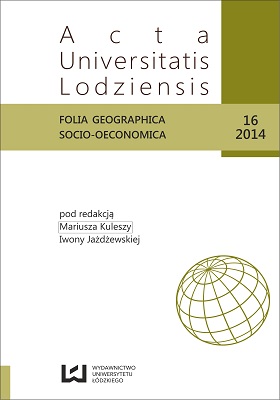Possible development analysis of the areas located along the second metro line in Warsaw
DOI:
https://doi.org/10.18778/1508-1117.16.12Keywords:
geospatial analysis, metro, urban development,, land use changeAbstract
The aim of this study was to analyze the development of areas located along the second metro line in Warsaw using the modified MOLAND model. The area of analysis was set at a distance of 500 meters from the subway line. Four databases were used as an input: current use of the land, map-based transport accessibility, site plans and potential development areas databases. The results show that areas located within the existing plan, situated not more than 500 meters from the metro station and designated as an area of development will develop the fastest. The slowest, will change areas located further than 750 meters from the station and without an abiding site plan. Fastest-growing terrains are bestead mostly in small and built-up areas. The most extensive changes take place in areas currently partially or generally undeveloped, but without proper infrastructure development they are likely to slow down. This model could be used especially for spatial planning by city authorities.
References
Andrzejewski M., 2011, Od Londynu do Warszawy: zarys dziejów metra, Wydawnictwo Uniwersytetu Gdańskiego, Gdańsk.
Google Scholar
Arozarena A., Villa G., Valcárcel N., 2006, New Concept On Land Cover/Land Use Information System In Spain. Design And Production, Cartographic Production Department, National Geographic Institute
Google Scholar
Beim M., 2007, Modelowanie procesu suburbanizacji w aglomeracji poznańskiej z wykorzystaniem sztucznych sieci neuronowych i automatów komórkowych, rozprawa doktorska napisana w Zakładzie Ekonometrii Przestrzennej, Instytut Geografii Społeczno-Ekonomicznej i Gospodarki Przestrzennej, Uniwersytet im. Adama Mickiewicza w Poznaniu, Poznań.
Google Scholar
Bielecka E., Ciołkosz A., 2005, Pokrycie terenu w Polsce. Bazy danych CORINE Land Cover, Biblioteka Monitoringu Środowiska, Warszawa.
Google Scholar
Bossard M., Feranec J., Otahel J., 2000, „CORINE land cover technical guide: Addendum 2000”.
Google Scholar
Brennan M., Twumasi B.O., 2008, Does MOLAND work as a tool for the assessment and/or as a predictor of the distribution of urban biodiversity in Dublin city?, Ireland: University College Dublin, Urban Institute.
Google Scholar
Grzybek M., 2006, Historia budowy metra w Warszawie, praca magisterska wykonana w Instytucie Socjologii UW, Uniwersytet Warszawski, Warszawa.
Google Scholar
Kozłowski R. (red.), 2012, Znaczenie i skutki budowy wybranych elementów infrastruktury nowoczesnego transportu kolejowego, Wydawnictwo Uniwersytetu Łódzkiego, Łódź.
Google Scholar
DOI: https://doi.org/10.18778/7525-631-4
Królewski P., 2010, Analiza zmian pokrycia terenu dla dzielnic: Mokotów, Ursynów, Wilanów, Śródmieście w latach 1992‒2002 na podstawie zdjęć satelitarnych SPOT, praca magisterska wykonana na Politechnice Warszawskiej, Politechnika Warszawska, Warszawa.
Google Scholar
Markiewicz M., 2012, Analiza możliwości rozwoju obszarów położonych wzdłuż drugiej linii metra warszawskiego, praca magisterska wykonana na Politechnice Warszawskiej, Politechnika Warszawska, Warszawa.
Google Scholar
Miejska Pracownia Planowania Przestrzennego i Strategii Rozwoju, 2006, Studium uwarunkowań i kierunków zagospodarowania przestrzennego dla miasta stołecznego Warszawy, Warszawa.
Google Scholar
Miejska Pracownia Planowania Przestrzennego i Strategii Rozwoju, 2006, Opracowanie ekofizjograficzne dla studium uwarunkowań i kierunków zagospodarowania przestrzennego dla miasta stołecznego Warszawy, Warszawa
Google Scholar
Miejska Pracownia Planowania Przestrzennego i Strategii Rozwoju, 2006, Studium uwarunkowań i kierunków zagospodarowania przestrzennego dla miasta stołecznego Warszawy, Warszawa
Google Scholar
Pátíková A., Kemper G., Lavalle C., 2000, Monitoring Urban Dynamics for Bratislava in 1949–1997, International Archives of Photogrammetry and Remote Sensing, Vol. XXXIII, Part B7, Amsterdam.
Google Scholar
Rossman J. (red.), 1962, Studia i projekty metra w Warszawie 1928–1958, Wydawnictwo Arkady, Warszawa
Google Scholar
Shahumyan H., White R., Twumasi B.O., Convery S., Williams B., Critchley M., Carty J., Walsh C., Brennan M., 2009, The MOLAND Model Calibration and Validation for the Greater Dublin Region, University College Dublin, Urban Institute Ireland, Dublin.
Google Scholar
Tang J., Wang L., Yao Z., 2007, Saptio-temporal urban landscape change analysis using the Markov chain model and a modified genetic algorithm, International Journal of Remote Sensing.
Google Scholar
DOI: https://doi.org/10.1080/01431160600962749
Uchwała Rady m. st. Warszawy nr XXXV/199/92 z dnia 28 września 1992 r., Miejscowy Plan Ogólny Zagospodarowania Przestrzennego m. st. Warszawy, Warszawa.
Google Scholar
Walczak R., Krupa A., 1975, Założenia techniczno-ekonomiczne budowy I linii metra w Warszawie, Warszawa
Google Scholar
Downloads
Published
How to Cite
Issue
Section
License

This work is licensed under a Creative Commons Attribution-NonCommercial-NoDerivatives 4.0 International License.








